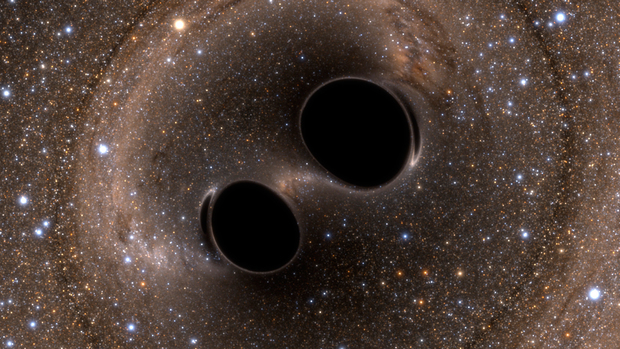Astronomers detect neutron star merger for the first time
November 5, 2017
Scientists detected a neutron star merger for the first time on Aug. 17 using two different methods of signal detection.
The neutron star merger, also known as a kilonova, sent signals that set off antennae and sensors that alerted scientists to a potential detection. This time, however, the collision was detected by two messengers: electromagnetic radiation and gravity waves.
A potential detection alert of a kilonova from the Laser Interferometer Gravitational-Wave Observatory (LIGO), whose founders won the Nobel Prize this year, piqued astronomers’ interest on Aug. 17. Unlike the black holes that LIGO previously detected, the kilonova, was expected to give off a visible explosion of light.
Seconds later, NASA’s Fermi Gamma-ray Space Telescope detected short gamma-rays coming from the same region of the sky. Then, the One-Meter Two-Hemispheres (1M2H) collaboration team based in UCSC was the first to find the source of the gravitational waves in a galaxy called NGC 4993 in the Hydra constellation and collect optical photons.
“It’s hard to understate how important this is. We’ve potentially started a new scientific field, one where we finally can look at the universe both through gravity and through light. In terms of what we’ve learned and what theories we’ve confirmed, it’s a long list,” Ryan Foley, principal investigator of the 1M2H collaboration and UCSC assistant professor of astronomy and astrophysics, said. “It’s kind of endless. There’s all sorts of things that we now know about the universe because of this one event.”
The neutron star merger is an important detection for not only astronomy, but also engineering and physics as well. The detection confirms Einstein’s general theory of relativity and provides valuable detail on kilonovas that have only been theorized about up to this point.
Once a star cannot raise its interior temperature high enough to undergo further fusion, it dies. In simple terms, every star’s death process passes through at least one of three stages: as a white dwarf, a red giant, or a neutron star.
The smallest, most dense of these stars is the neutron star. As the fusion energy of a star runs out, the star, compressed by its own large gravitational energy, begins to collapse in upon itself. However, due to the electron degeneracy pressure and the electrons in the atoms violating the Pauli exclusion principle, the outer clouds of atoms begin to push back, supporting the star against its own weight.
“[A neutron star is] material that’s so compressed that, even though it has a mass that’s one to two times the size of the sun, it’s compressed into a region of space that’s not much bigger than Manhattan Island,” UCSC professor of astronomy and astrophysics and astronomer Dr. Puragra Thakurta said. “It’s a remarkable degree of compression.”
This detection yields more than a discovery of a kilonova. While scientists gained valuable details on neutron star mergers, a new field of astronomy may also have been born.
“I do consider this to be a watershed moment,” said Dr. Thakurta. “Astronomical objects send off signals, and it’s two very different kinds of signals that were received, and that’s what’s special about this event. They’re calling it the birth of multi-messenger astronomy.”


















![“[Building nerf blasters] became this outlet of creativity for me that hasn't been matched by anything else. The process [of] making a build complete to your desire is such a painstakingly difficult process, but I've had to learn from [the skills needed from] soldering to proper painting. There's so many different options for everything, if you think about it, it exists. The best part is [that] if it doesn't exist, you can build it yourself," Ishaan Parate said.](https://harkeraquila.com/wp-content/uploads/2022/08/DSC_8149-900x604.jpg)




![“When I came into high school, I was ready to be a follower. But DECA was a game changer for me. It helped me overcome my fear of public speaking, and it's played such a major role in who I've become today. To be able to successfully lead a chapter of 150 students, an officer team and be one of the upperclassmen I once really admired is something I'm [really] proud of,” Anvitha Tummala ('21) said.](https://harkeraquila.com/wp-content/uploads/2021/07/Screen-Shot-2021-07-25-at-9.50.05-AM-900x594.png)







![“I think getting up in the morning and having a sense of purpose [is exciting]. I think without a certain amount of drive, life is kind of obsolete and mundane, and I think having that every single day is what makes each day unique and kind of makes life exciting,” Neymika Jain (12) said.](https://harkeraquila.com/wp-content/uploads/2017/06/Screen-Shot-2017-06-03-at-4.54.16-PM.png)








![“My slogan is ‘slow feet, don’t eat, and I’m hungry.’ You need to run fast to get where you are–you aren't going to get those championships if you aren't fast,” Angel Cervantes (12) said. “I want to do well in school on my tests and in track and win championships for my team. I live by that, [and] I can do that anywhere: in the classroom or on the field.”](https://harkeraquila.com/wp-content/uploads/2018/06/DSC5146-900x601.jpg)
![“[Volleyball has] taught me how to fall correctly, and another thing it taught is that you don’t have to be the best at something to be good at it. If you just hit the ball in a smart way, then it still scores points and you’re good at it. You could be a background player and still make a much bigger impact on the team than you would think,” Anya Gert (’20) said.](https://harkeraquila.com/wp-content/uploads/2020/06/AnnaGert_JinTuan_HoHPhotoEdited-600x900.jpeg)

![“I'm not nearly there yet, but [my confidence has] definitely been getting better since I was pretty shy and timid coming into Harker my freshman year. I know that there's a lot of people that are really confident in what they do, and I really admire them. Everyone's so driven and that has really pushed me to kind of try to find my own place in high school and be more confident,” Alyssa Huang (’20) said.](https://harkeraquila.com/wp-content/uploads/2020/06/AlyssaHuang_EmilyChen_HoHPhoto-900x749.jpeg)











